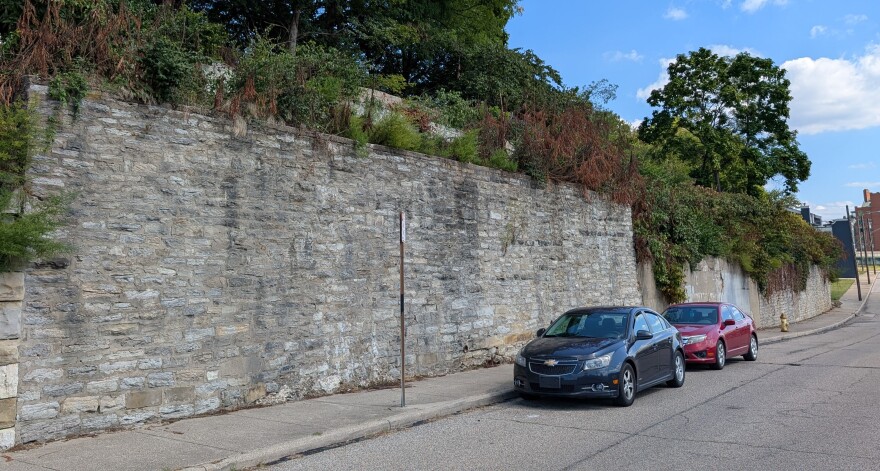You've got questions, and WVXU has the time and ability to find some answers. In this edition, OKI Wanna Know looks at the slopes of Mount Adams, and tries to find out what used to sit there, with WVXU's Bill Rinehart.
Cortney Scheeser of Mariemont had his curiosity piqued while he was walking near Downtown.
"There is a really cool ruin on the edge of Mount Adams, that has an old historic lintel, about an old convent. It would have overlooked Downtown probably a hundred years ago," he says. "Now it's bricked in and I'm curious about the history of that convent and how it connected to Mount Adams."
A lintel, if you're not familiar, is the horizontal beam above a doorway. This one has the words "The Convent of the Good Shepherd" carved in stone. Vegetation is covering it, so if there weren't an obvious bricked-up doorway, it would be easy to assume there's nothing there except a retaining wall.

The Catholic Church has a big footprint and a lengthy history in Cincinnati. There were dozens of parishes around the basin.
Father David Endres is the academic dean of Mount St. Mary Seminary and a church historian. He says many of those parishes closed as the population moved around.
"And that is certainly something that impacted Mount Adams," he says. "You have an area that has a lot of Germans, but also a lot of Irish. Immaculata was the German parish; Holy Cross was the Irish parish.
Endres says Immaculata was the first Catholic Church in the neighborhood.
"And the story goes, of course as they're building this, people from down in the city are looking up and saying 'What's going on up there?' " he says. "They start wearing a path up the hillside, and that's the starts of all the steps and the devotion on Good Friday of praying the steps."
That wasn't the only Catholic presence up there. Endres says Holy Cross had a monastery.
"You also have two parochial grade schools, both Holy Cross and Immaculata. And at least for a time, Immaculata had an industrial high school. This is prior to the 1920s when they started the more consolidated high schools in Cincinnati," he says. "So if you think about it, there's probably easily five or six different Catholic institutions existing just on Mt. Adams."
Which leads us back down to near the base of the hill, and the Convent of the Good Shepherd.
Endres says that order came to Cincinnati around 1857, at the request of philanthropist Sarah Worthington King Peter.
"And she goes over to Europe, is very impressed with these nuns that she meets, and she decides the best thing for Cincinnati is to bring in these different groups," he says. "She brings in a variety of either European — or in some cases, they're already in the United States — communities."
Endres says she attracts the Little Sisters of the Poor, and the Passionist Fathers, who ran the Holy Cross parish, and the Monastery on Mt. Adams. Sarah Peter also draws the Sisters of the Good Shepherd.
"They had a special mission to work with what they called at the time 'wayward girls,' " he says. "So, at a time when there really wasn't the same kind of social service and safety nets that we have in our society now, that was one of the ways in a sense to send them to the sisters for reform."
The order built its convent on Baum Street, and moved in around 1873. Andres says the young women were sent for education and reform, but if they wanted to, they could stay to become nuns.
Endres says the only records he found indicated the convent would house about 40 penitents, the young women there for reform, and about 20 younger girls.

"It kind of seemed to exist at times as, certainly a convent, but also orphanage, reform school, and even industrial school, where they would teach trades, things like sewing, embroidery, laundry," he says.
Around 1904, Endres says the sisters left Mt. Adams.
"When the convent does move from Mt. Adams, it actually takes up residence in Price Hill, which had been our seminary," he says.
Mount St. Mary's Seminary becomes the Mount St. Mary Training School for Girls. He says the sisters also were active in the West End, and around North Bend Road, with Girls Town, near St. Xavier High School.
"I don't know if it was in the 1970s or so, I believe that basically things started to change in terms of recommended ways of working with young people," he says. "I think that the order ends up moving. The only location that I know of that's in this — at least in the Midwest area — is in St. Louis."
The building that housed the convent is gone now. All that's left is the retaining wall on Kilgore and the lintel. It was above a set of stairs, which led to the backdoor of the convent.
About a hundred feet to the northwest was the Mt. Adams Incline, and across Kilgore Street, the William J. Morgan Public School, both of which also are gone.
Read more:




